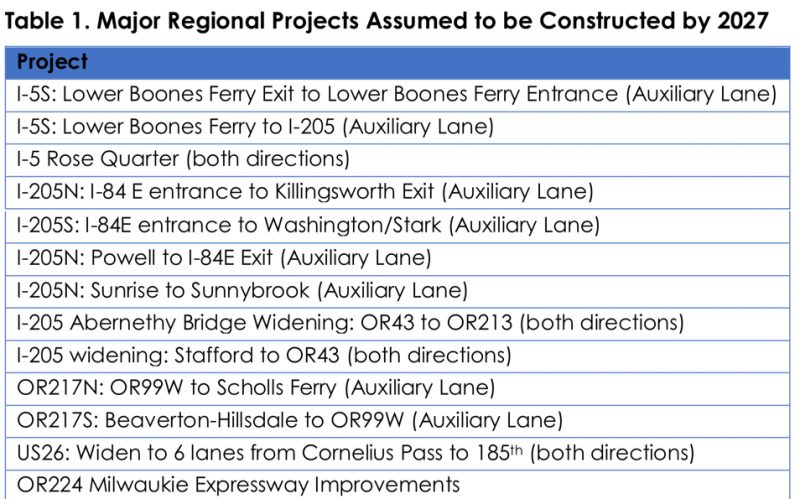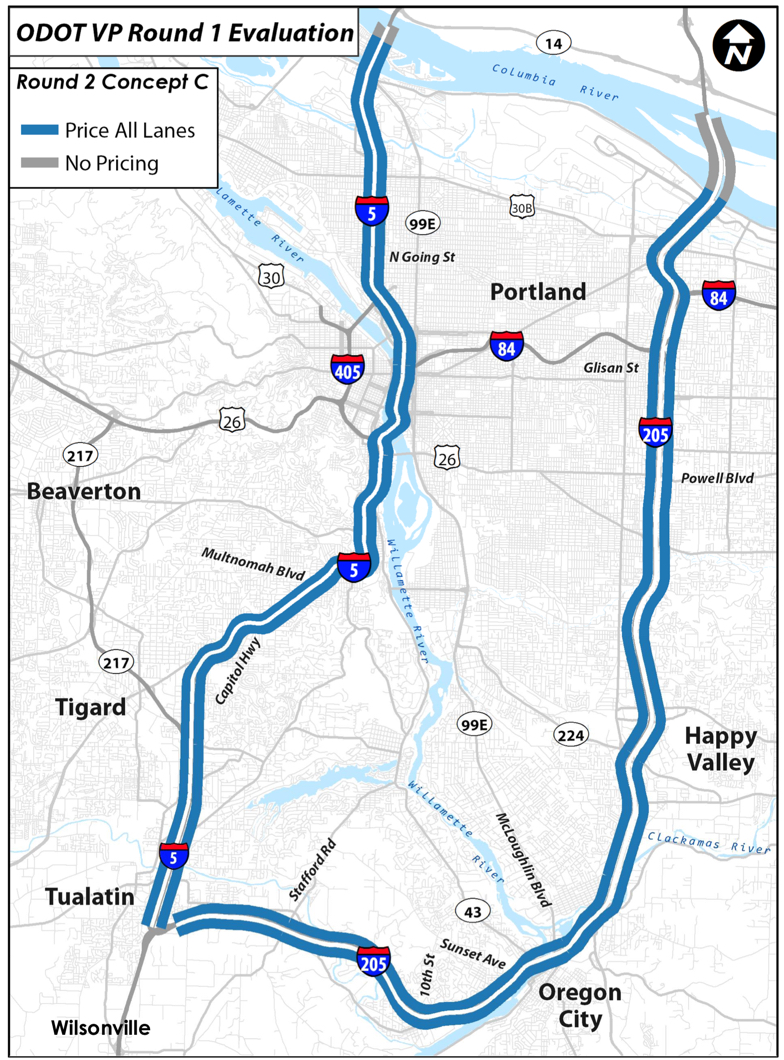“Significant congestion will exist in 2027 on the I-5 and I-205 study corridors, even with all the improvements listed in the Regional Transportation Plan.”
— from a report published by ODOT as part of their Value Pricing Feasibility Analysis
The ODOT Files is our attempt to keep you informed of stories from around the web that illustrate how our state transportation agency is falling down on the job.
The latest entry into the ODOT Files is a story by Dirk VanderHart published today in the Portland Mercury: A New Report Shows Highway Widening Won’t Solve Portland’s Congestion Woes.
The piece centers around ODOT’s Value Pricing Advisory Committee, a group of advocates, electeds, and transportation leaders tasked with determining whether or not we should toll highways — and if so, how exactly it should be implemented. The central tension here is that ODOT wants to build lots of new highways (including an expansion of I-5 through the Rose Quarter) and there’s increasing political and public demand to consider tolling them before — or instead of — building them.
Then there’s the fact that expanding highways does not relieve congestion. And based on the Mercury story, even ODOT’s own analysts are trying to tell them that:
… according to a firm hired by the Oregon Department of Transportation (ODOT), none of the dozen highway-widening projects that are currently being planned in and around Portland by state officials would be enough in coming years to stem the increasing congestion choking Portland highways.
“Baseline, significant congestion will exist in 2027 on the I-5 and I-205 study corridors, even with all the improvements” currently envisioned, reads a new analysis from Montreal-based engineering firm WSP. “This congestion impacts not only speed, but also the number of vehicles that the facility can accommodate, with consequential impacts upon quality of life, economic vitality, and vehicle emissions in the region.
Take a closer look at the firm’s findings in the source document: Round 1 Concept Evaluation and Recommendations Technical Memorandum #3 (PDF).
And here’s VanderHart’s reporting on the growing calls to toll first, build later (or never):
Now some local leaders are asking a follow-up question. As officials study the concept of fighting congestion—and potentially curbing auto use—by tolling portions of I-5 and I-205, some want to know if tolls could aid commuters even without the state dropping billions on new highway lanes.
“What would be the impact of tolling all roads everywhere, assuming roads look like what they look like now?” Metro Councilor Craig Dirksen asked at a February 28 meeting of the state’s 25-member Value Pricing Advisory Committee, which is slated to recommend a scheme for tolling by the end of the year. “That’s a scenario that needs to be considered.”
“I think that’s a worthwhile look to have,” said another committee member, Multnomah County Commissioner Jessica Vega Pederson, a short while later.
Gerik Kransky, policy director for the active transportation advocacy group the Street Trust, also pushed the concept.
If ODOT follows their lead, Portland could get a sense of how tolling, by itself, could ease the city’s traffic woes. Anti-highway activists suggest such information would offer valuable context when deciding, say, whether a $450 million widening project makes sense.
The analysts hired by the state seem to bolster that point, saying tolling could have a meaningful impact without widening local highways.
Specifically, one concept analyzed in the report is to price all lanes of I-5 and I-205 within the study corridors from the Washington border to the merge of I-5 and I-205. It got a glowing review:
This alternative provides significant congestion relief as it maximizes the ability to manage traffic efficiency on north-south freeways the length of the entire region. This alternative is likely to raise the most revenue that could be used to improve geometric conditions on area roadways, and could provide capital revenue for transit projects on the roadways, or other mitigation measures. Compared to the expense of adding new roadway lanes, this alternative is relatively inexpensive to implement. As described in the evaluation, the Priced Roadway – Toll All Lanes initial concept was the most effective at reducing congestion. It also would likely result in the highest net revenue. As such this concept may have the most opportunity for tolling during congested times of the day while providing the most funding toward mitigation strategies.
Read the Mercury story for more.
Previously, in the ODOT Files:
➤ Din from bypass has some neighbors on edge – 2/15/18 via The Newberg Graphic
➤ 97% of sidewalk ramps along Oregon highways violate ADA standards, survey finds – 2/16/18 via The Oregonian
➤ Our streets should be safe for everyone – Yes, even those who are under the influence– 2/28/18 via Strong Towns
— Jonathan Maus: (503) 706-8804, @jonathan_maus on Twitter and jonathan@bikeportland.org
Never miss a story. Sign-up for the daily BP Headlines email.
BikePortland needs your support.
The post The ODOT Files: Portland Mercury checks in on freeway tolling efforts appeared first on BikePortland.org.
from Latest headlines from BikePortland http://ift.tt/2FoJJya




No comments:
Post a Comment